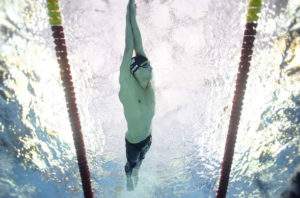The most important part of a swim race isn’t above the water…its below.
When you think of swimming, you almost always picture swimmers kicking, splashing, and moving their arms over the water. Although this is definitely a huge aspect of swimming fast, it falls second to another part of the race that is more important to producing fast times: the underwaters.
What are underwaters? When swimmers dive in and form a streamline, they are doing underwaters. When swimmers change directions at the wall, they push off while doing an underwater. An underwater is the portion of the race where swimmers take advantage of the speed they have from pushing off the wall or from diving into the pool.
Underwaters are important because they can make upwards of a third of the total distance swam for a race. Some races like the 50 breaststroke and backstroke can even have more of the race spent underwater than above the water! The reason swimmers stay underwater for so long is because they can use their strong kick to propel them faster through the water than above; they can combine the strong kick from the powerful push from the wall to go even faster.
Beyond underwaters just being faster, underwaters are beneficial for swimmers because you spend less time moving your arms during the race. Being able to go a third of the way underwater allows your arms to take a quick rest so when you pop back up, you can move them with just as much speed as before, even if you are more tired!
One of the greatest swimmers of all time Caleb Dressel broke the world record for the 50 freestyle in 2018. During that race, he went underwater for more than half of the entire swim! Check out how far he went in the video!
For new swimmers, being able to stay underwater and kick to drive them forward is a valuable skill to learn. Learning underwaters from a young age helps swimmers accomplish the one ultimate goal of swimming: finish the race as fast as possible! Underwaters shouldn’t be easy, swimmers should jump at the chance to pull ahead of the competition using those underwaters! One easy way to train this skill is just by setting a mark that you must reach before starting to swim again. This could be the flags, a line on the bottom of the pool, or a specific color on the lane line–its totally up to you!
Thinking about hitting that mark every single wall will build your underwater strength quicker than you would ever expect!

